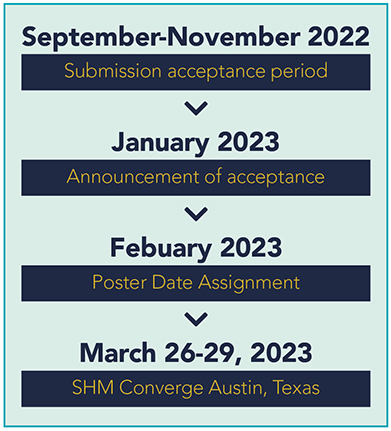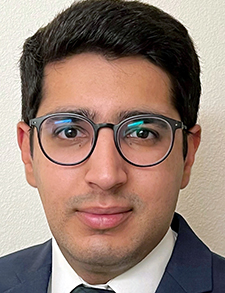Today’s the day to start thinking about submitting a scholarly project to SHM Converge 2023. Our job is to convince you why it’s important and show you how to proceed. Our advice is based on our experience of applying to SHM Converge 2022.
What is SHM Converge?
SHM Converge is an annual meeting that serves as an opportunity to engage in hospital medicine research or workshops, learn about new topics in the field, and network.
Why should you submit your work to SHM Converge?
SHM Converge provides an opportunity to share knowledge during its annual scientific abstract competition through research, innovation, or interesting patient vignettes. For instance, if you have an inpatient research project, this conference is the perfect way to disseminate your findings. The competition has recently received more than 1,700 abstract submissions for its 1,200 poster spots, so being able to include this national poster presentation on your resume is no small feat. Plenary and oral presentation slots are also offered to select authors. Abstracts are published in a Journal of Hospital Medicine online supplement.
SHM Converge is also a venue to receive informal feedback. Conference attendees can identify additional ways to interpret results or suggest individuals who would be interested in collaboration; this input can help a poster turn into a publication. Whether you’re a medical student or a seasoned attending, it’s a safe space to practice presenting information in a formal setting. Finally, attending SHM Converge is a chance to learn from colleagues. Educational sessions are targeted toward a wide variety of learners, ranging from medical students to residents, to attendings. The four-day event offers multiple opportunities to network with others who may share similar interests and to promote future collaborations.
What types of abstracts are accepted?
There are three competition abstract categories: research, innovations, and clinical vignettes. Abstracts can focus on children or adults as long as they have relevance to hospital medicine. Abstracts cannot have been published in a peer-reviewed journal before December 31 leading up to the conference but are still eligible if they were presented at another conference in the past year.
1. Research
This category includes basic science research, clinical research, and systematic reviews of clinical problems. Topics that touch on cost, efficiency, and quality of health care are also within this category. For instance, one of our projects looked at reasons behind delayed discharges for patients discharged on a Monday who could have left earlier.
Some examples are:
- A study on the prognostic value of labs ordered on patients with COVID-19 to determine which labs correlated with mortality and ICU stay
- An evaluation of residents’ attitudes toward patient discharge instructions before and after an educational module
- A quality improvement project looking at the outcomes of an inpatient team dedicated to initiating buprenorphine and facilitating transition to outpatient opioid use treatment
2. Innovation
This category includes any activity that has been piloted or implemented in the health care setting. This includes patient safety, electronic medical records, medical education, communication, and clinical pathways. This category is the most flexible and typically contains a description of the innovation, although preliminary data is welcome. If I had come up with an intervention to reduce delayed discharges but did not have the outcome data yet, I could still submit it here.
Some examples are:
- Developing programs to disseminate COVID protocols to underserved areas
- Implementing a patient safety simulation program in which residents had to identify errors or near miss events
- Creating a checklist to assist nurses with utilization of non-invasive positive pressure ventilation after a safety event
3. Clinical vignettes
A clinical vignette showcases a patient case relevant to hospital medicine with an interesting clinical feature. The abstract typically highlights the patient history, exam, laboratory data, management, and overall patient outcome with key learning points emphasized. It’s more important to have a case relevant to hospitalists than to have an extremely rare case where the hospitalist is only peripherally involved. Vignettes should have input from anyone critical to the case and use patient-centered language that avoids stereotyping.
Some examples are:
- A near misdiagnosis in which a young man with a family history of Crohn’s disease presented with bloody diarrhea and was initially planned for a colonoscopy but later found to have E Coli gastroenteritis
- A case of thiamine deficiency presenting with symptoms of wet, dry, and gastrointestinal beriberi
- A patient thought to have COVID-19 pneumonia but ultimately found to have Pneumocystis jirovecii pneumonia in the setting of newly diagnosed HIV
How do I prepare to submit to SHM Converge?

Timeline of SHM Converge Abstract Submissions
Now that you’re excited to apply to SHM Converge, it’s time to discuss the next steps. Research projects typically take at least three months to complete; try reaching out to faculty and peers who share common interests to see what projects are available for you to join, or give yourself a longer time period if you’re looking to start something from scratch. If you’ve started a project but it’s incomplete, consider submitting an innovation abstract. Clinical vignettes can be more manageable if you’re short on time; it helps to keep track of interesting cases as you see them. Authors can submit multiple submissions in different categories.
Once you have a project in mind, share your goal of applying to SHM Converge with any anticipated collaborators. By setting a deadline ahead of time and determining the order of authors, everyone on the team can have a shared goal.
It is important to work on submission materials at least one month before the deadline in case any unforeseen issues arise. This includes looking at the conference website to learn about the abstract submission requirements. No worries if you don’t have enough space to write up all the information you discovered; if accepted, the poster will have room to include other data or images. The abstract is where the most important details are written. Authors must be SHM members to present.
It will take time to write up the abstract and have each collaborator review it for grammar and clarity, the relevance of the results to a hospitalist audience, and the overall message. For me, the most time-consuming part was addressing the questions my mentors posed. It was stressful to complete the abstract on time, so try to finish early, if possible!
Finally, it is almost time to submit! You and your team have put a tremendous amount of effort into your final product, so be sure to submit it before the deadline in case something comes up in your life or with the website. Once you are done, you will hear the results of your submission in January 2023. Good luck!
Learn more about SHM Converge 2023 and SHM Abstract Guidelines.
This content is sponsored by the SHM Physicians in Training (PIT) committee, which submits quarterly content to The Hospitalist on topics relevant to trainees and early career hospitalists.
 Dr. Shyu is a resident in the department of internal medicine, Icahn School of Medicine at Mount Sinai, New York.
Dr. Shyu is a resident in the department of internal medicine, Icahn School of Medicine at Mount Sinai, New York.
 Dr. Sheikh is a hospitalist and associate program director in the department of internal medicine, University of New Mexico, Albuquerque, N.M.
Dr. Sheikh is a hospitalist and associate program director in the department of internal medicine, University of New Mexico, Albuquerque, N.M.
 Dr. Barrett is a hospitalist (locum tenens) in New Mexico.
Dr. Barrett is a hospitalist (locum tenens) in New Mexico.